Hainanese Chicken Rice – Khao Man Gai
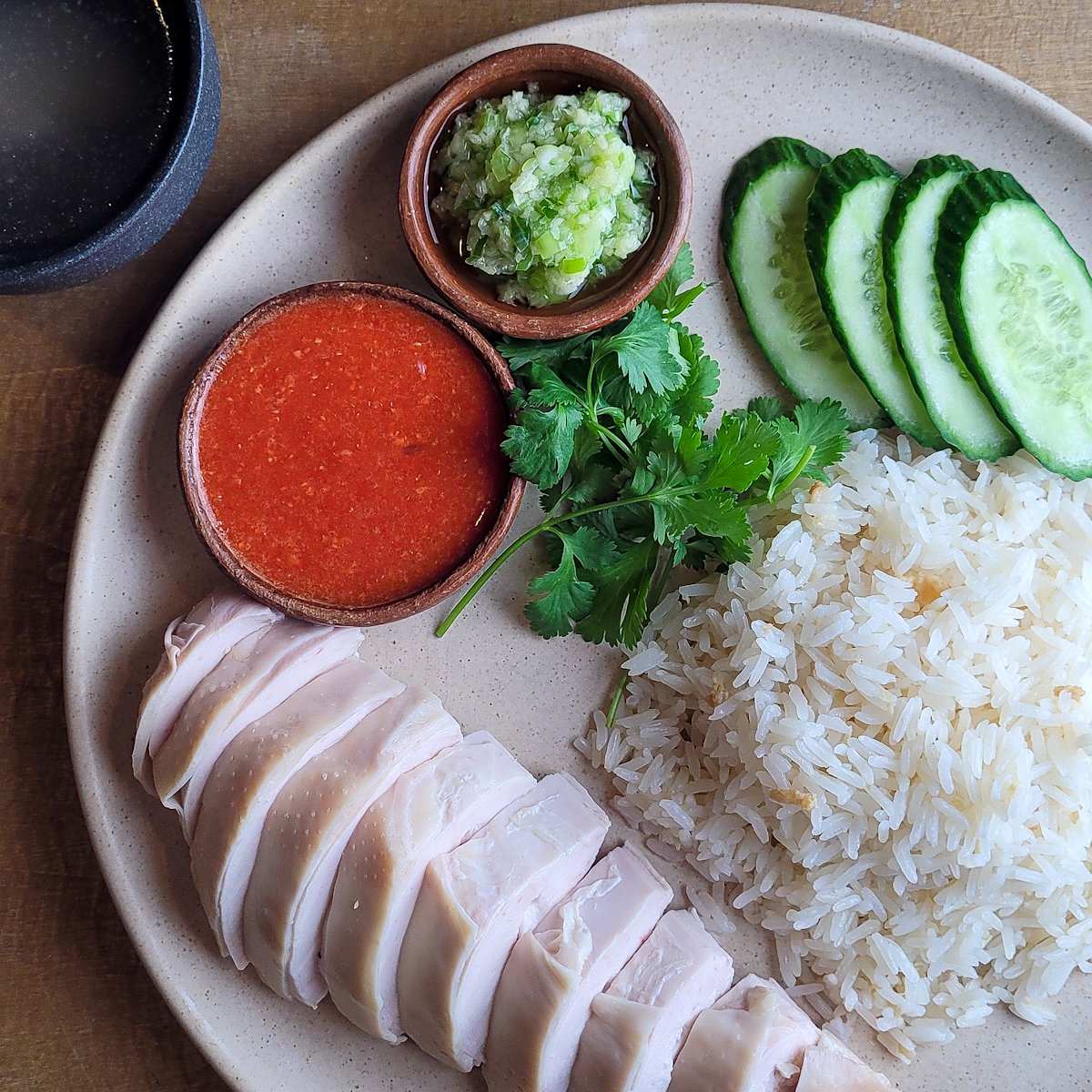
Hainanese chicken rice is one of my favorite “street” foods of all time. This dish is very popular in Singapore, Malaysia, and Thailand. Each country has slight variations on the same dish (the accompanying sauces are what seem to vary the most), and they are all delicious. Gently poached, room-temperature chicken is served with garlicky rice that is cooked using the chicken poaching liquid. That same broth is also served alongside the chicken rice as a “sidecar”, meant to be sipped between bites. There is typically at least one sauce served with the chicken, today we will be making a simple chili garlic sauce (cili garam), and a ginger-scallion sauce.
This dish is a bit of a project but is definitely worth the effort. The sauces can be made ahead of time and will keep for a few days in the fridge. You could also just make one of the sauces if you want to simplify the whole process.
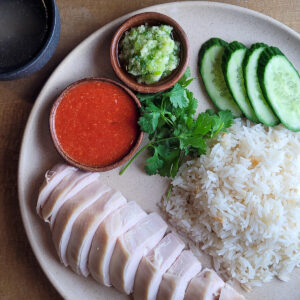
Hainanese Chicken Rice
Equipment
- Large pot that will comfortably fit a whole chicken (8 quarts or larger)
- 4-6 quart pot for cooking rice
- Small pot for rendering chicken fat and frying garlic (about 1 qt)
- butchers twine (optional)
- Probe thermometer (optional but recommended)
- Blender (for the chili-garlic sauce)
Ingredients
Poached Chicken
- 1 whole chicken. Ideally a lean, free-range chicken (3-4 pounds)
- 1/2 pound chicken bones (optional)
- 1 small spanish onion, peeled and cut into large chunks
- 4 scallions, cut in 2-inch pieces and roots discarded
- 2-3 ounces ginger, peeled and cut in 1/4 inch slices
- 1 tbsp soy sauce
- 2 tsp sesame oil
- 1 tsp MSG (optional)
- salt, to taste
Garlic Rice
- 1-2 oz chicken skin and fat, reserved from the whole chicken
- 1/2 cup chopped garlic
- 3 cups jasmine rice (try not to substitute another type of rice)
- 1-2 tbsp neutral flavored cooking oil (canola, vegetable, corn….etc)
- 3.75 cups chicken broth, reserved from poaching the chicken
- salt, as needed
Soup
- about 8 cups chicken broth, reserved from poaching the chicken
- 2-inch piece of daikon radish (could also use some cabbage or winter melon)
- salt as needed
- 4 tbsp roughly chopped cilantro
Scallion-ginger sauce
- 1/3 cup finely chopped ginger
- 1/2 cup finely chopped scallion
- 1/3 cup neutral flavored cooking oil (canola, vegetable, corn….etc)
- about 3 tsp kosher salt
Chili-garlic sauce (Cili Garam)
- 7 ounces red long hot chilis ***see note*** (about 2 cups after roughly chopping)1.4
- 1 ounce garlic cloves (about 6 cloves)
- 1/4 ounce peeled ginger (about 1/2 inch thick slice)
- 6 tbsp lime juice
- 2 tbsp water
- 1/2 tsp MSG
- about 5-6 tsp kosher salt
To serve
- cucumber
- cilantro
Instructions
Scallion-ginger sauce
- Place the finely chopped ginger and scallion in a heat-proof metal bowl.
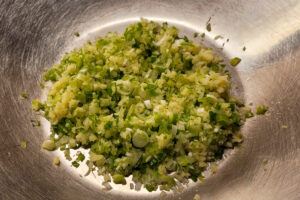
- Bring the neutral oil up to 450F in a small pot. If you do not have a thermometer, heat the oil until you start to see a few wisps of smoke.
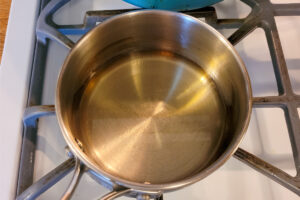
- Carefully pour the hot oil over the scallion-ginger mixture. It should bubble up aggressively when you do this.
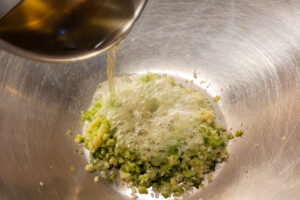
- Season this mixture with salt. This sauce should be quite salty on its own. I used about 3 tsp of kosher salt. Allow the sauce to come to room temperature before serving.
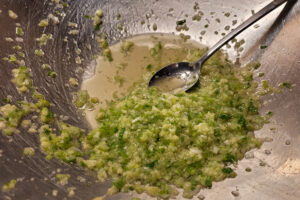
Chili-garlic sauce (Cili Garam)
- This recipe will yield more sauce than you need for just this dish. Keep any excess sauce as it works well as a general-purpose hot sauce.
- Wash and cut the peppers into pieces so that they will blend easily. If you are sensitive to heat, you can also remove the seeds.
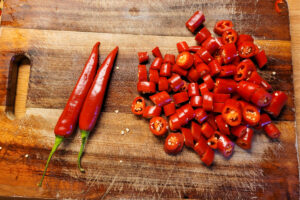
- Make sure the ginger and garlic are peeled before blending. I added a few Thai bird chilies because I like it extra hot.
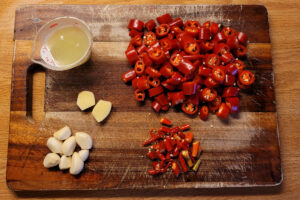
- Place all of the ingredients into the blender and process until a smooth sauce is formed. Season to taste with salt. The sauce should be salty on its own, that way it helps to season the chicken when you eat them together. Set sauce aside until ready to serve.

Poached Chicken
- Remove any excess skin or fat that you find on the chicken, this will be used later to make the rice. There is usually extra skin at the neck and near the opening of the cavity. Set this skin and fat aside.
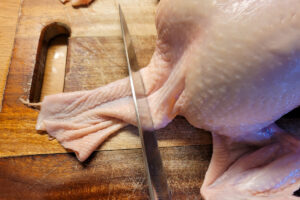
- This is the fat near the cavity. Cut it away with a knife and set it aside.
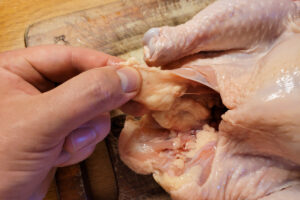
- Here you can see the chicken, the skin and fat that will be used later, and the optional chicken bones that will be used to add a bit more flavor to the poaching liquid.
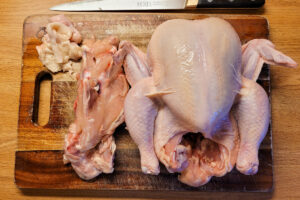
- Now we will tie the bird to make it easier to dunk in and out of the poaching liquid. Cut a 2-foot long piece of butchers twine. Lay the chicken on a cutting board with the breast facing up and closest to you. Place the twine under the chicken as shown. One end of the twine should be longer than the other so that it can be used as a "handle"

- Pull the two ends of the twin OVER the wings and towards you.The twine should be sitting against the chicken's "armpits"
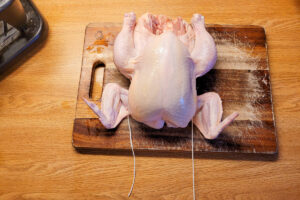
- Tie the twine tightly just behind the opening of the neck.
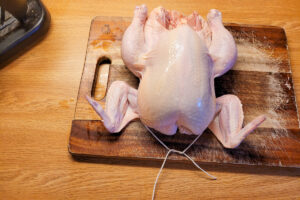
- It should look like this after tying.
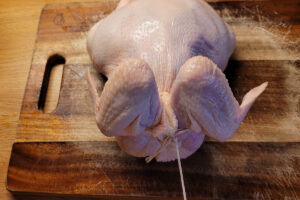
- You should be able to pick up the chicken using just the butchers twine. If the twine is not staying put, adjust your knot and its tightness until it holds the weight of the chicken.
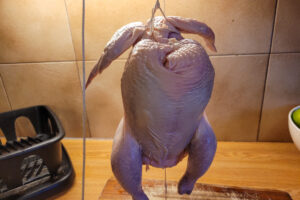
- Now we will check the size of the pot and the amount of water necessary to cook the chicken. Place the chicken, chicken bones, scallions, onion, and ginger into the large stockpot and cover everything with water. The whole chicken should be completely submerged in water. Remove the whole chicken from the pot and set it aside for now. Bring everything else that is in the pot up to a boil over high heat. You now have the correct amount of water in the pot. The pot will not overflow when you add the whole chicken to the boiling broth later.
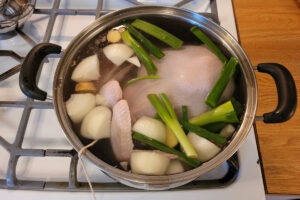
- Once the water has come to a boil, reduce the heat and cover the pot. Allow the liquid to simmer for 20 minutes. This helps extract some of the flavor from the chicken bones. If you are not using chicken bones, skip this simmering step. Once the broth has simmered for 20 minutes, add 1 tsp of msg and season the "soup" until it tastes like a pleasantly seasoned soup. The amount of salt will vary depending on how much water is in your pot.
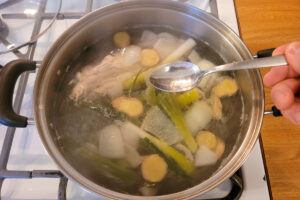
- Bring the broth back up to a rolling boil over high heat and then "dunk" the chicken in and out of the boiling broth 3 or 4 times. This dunking ensures that the cavity of the chicken is filled with hot liquid at the beginning of the cooking process.

- After dunking, lay the chicken into the pot. I like place a small heat-proof plate under the chicken while it is cooking so that the skin does not come in direct contact with the bottom of the pot. (It is better to have the breasts facing up when cooking the chicken so that the legs are closer to the heat source)
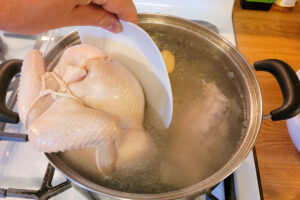
- Once the chicken is in the pot, turn the heat down to low or medium-low and allow the chicken to cook for about 45-60 minutes.
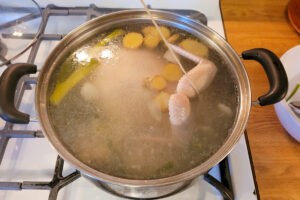
- During the cooking process, it is best to have the broth at just below a simmer. Here it is reading 180F on a thermometer. Do not let the broth get too cool or boil too aggressively. If it is too cool, it will take longer to cook, if it is boiling aggressively the chicken will overcook and the skin may tear. Cook the chicken until a probe thermometer inserted into the thigh near the bone reads 165F. If you do not have a thermometer, allow the chicken to cook for a full hour and then check the doneness by briefly removing the chicken from the water, making an incision near the bone of the thigh, and looking inside to make sure it is no longer raw.
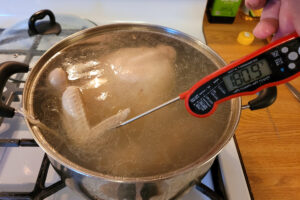
- When the chicken is finished cooking, carefully remove the chicken from the poaching liquid and lower it into an ice/water bath that has been lightly seasoned with salt. Allow the chicken to cool in the ice bath until it is about room temperature. STRAIN AND RESERVE ALL OF THE CHICKEN POACHING LIQUID!!!! You will need 3.75 cups for the rice and about 8 cups for the soup. Any remaining broth can be frozen and saved for other applications.

- When the chicken has cooled, remove the chicken from the ice bath, pat dry, and use a brush or your hands to rub 1 Tbsp of soy sauce and 2 tsp of sesame oil all over the chicken skin. Allow the chicken to sit at room temperature until ready to serve.
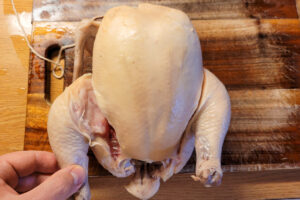
Garlic rice
- Finely chop the skin and fat that was reserved from the raw chicken.
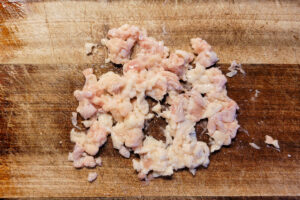
- Place the chopped skin in a small pot with 1-2 tbsp of water. Turn the heat on to medium low and allow the skin to begin to render.
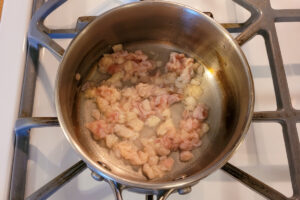
- Stir the skin occasionally as it cooks. At a certain point the water will evaporate and the skin will begin to fry in its own fat.
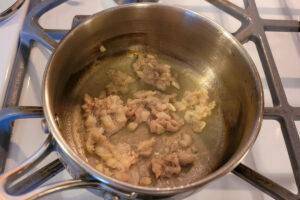
- At a certain point the skin will become golden brown and crisp. This can take anywhere between 10 and 20 minutes.
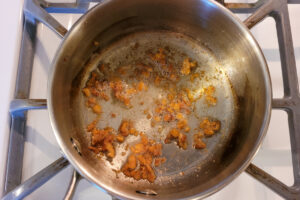
- When the skin is crispy, remove the skin from the pot and set it aside. Keep the rendered fat in the pot and turn off the heat. It is OK if there are still a few small bits of skin stuck to the bottom of the pot.
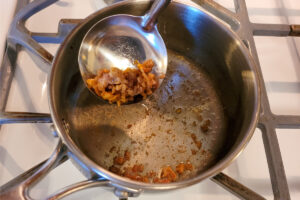
- Carefully measure how much fat is left in the pot. You need 3 Tbsp of fat in order to fry the garlic. If you have too much fat, discard some. If you do not have enough fat, supplement with canola oil until you have 3 Tbsp total of fat/oil.
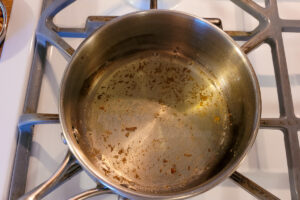
- Add 1/2 cup of chopped garlic to the pot with the 3 tbsp of reserved fat. Turn the heat on to medium-low and cook the garlic while stirring until it is golden brown and crispy.
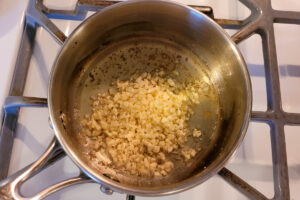
- The garlic may take 5-10 minutes to get golden brown and crispy. Once it has reached that point, turn off the heat and add the crispy chicken skin back into the pot with the garlic.
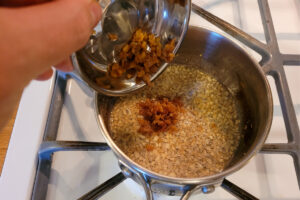
- Pour the crispy garlic and chicken skin, along with all of the fat, into a 4-6 qt pot with a lid.

- Add 3 cups of rice to the pot and stir to coat with the garlic/skin/fat mixture.
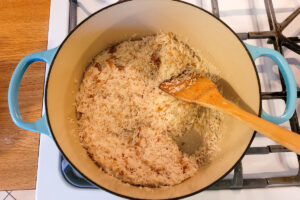
- Add 3.75 cups of the reserved chicken poaching liquid to the pot and turn the heat on to HIGH. Taste the broth and adjust the seasoning with salt until the broth tastes savory and well seasoned (you should not need too much salt as you seasoned the broth before cooking the chicken). Once the broth comes to a full boil, immediately cover the pot and turn the heat down to medium-low.
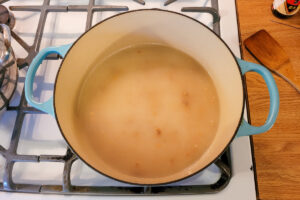
- Cook the rice for 15 minutes on medium-low heat. Do not open the lid while the rice is cooking. After 15 minutes, turn off the heat and allow the rice to sit for 10 minutes without opening the lid.
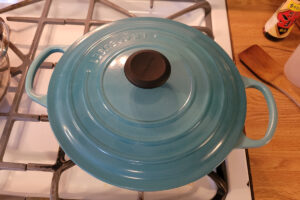
- After 10 minutes off the heat, you can open the lid and fluff the rice. Keep the rice covered until ready to serve.
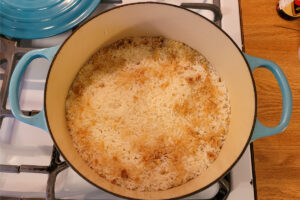
Soup
- Peel and cut the daikon into "half-moons" that are 1/2 inch thick.
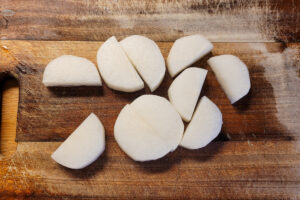
- Place the daikon into a pot with 8 cups of the reserved chicken poaching liquid and simmer for about 15-20 minutes, or until the daikon is soft. Add the chopped cilantro and season with salt to taste. Set aside until ready to serve

To serve
- Remove the breasts from the cooked chicken, leaving the skin intact. You should have two boneless breasts.
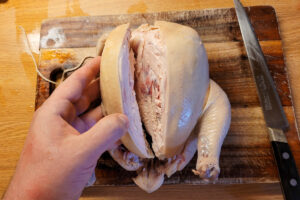
- Cut away the chicken legs, leaving as much skin intact as possible.
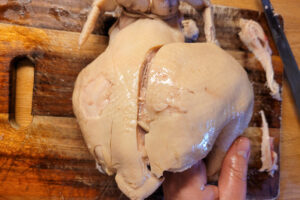
- Place the chicken legs skin side down on a cutting board and use a knife and your fingers to cut away and discard the leg bones. You should have two boneless leg quarters.
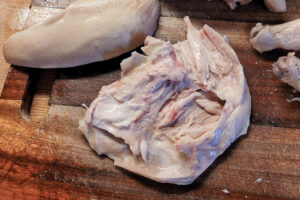
- Slice the chicken breasts and thighs.
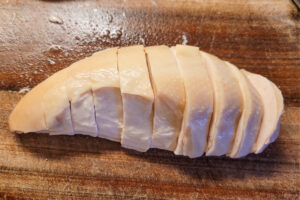
- Heat up the soup and pour into 4 small bowls. Lay out 4 plates and place some warm rice on each plate. Place a sliced breast or leg on the plate along with the rice, a few slices of cucumber, a few sprigs of cilantro and the 2 sauces. Enjoy.
